Class 113 DMU images
Page 1 of 2, displaying 1-20 of 39 images › »

circa November 1959
The Rolls-Royce engine under a Cravens power car. It is fitted with hydraulic transmission - the Twin-Disc torque converter is on the left hand side. Prominent on this side of the engine is the fuel pump, with four flexible air lines coming from pipes behind the solebar to the throttle motor at the bottom of the fuel pump - each pipe corresponding to a position on the drivers throttle controller in the cab. Cravens.

circa December 1959
A publicity image of a Rolls-Royce powered Cravens set with hydraulic transmission, later known as a Class 113. Closest is DMBS M51735, the DMBCL is presumably M51760, the pair were delivered in early December 1959 to Accrington, and this was taken at Darnall station. Cravens.

circa December 1959
A publicity image of DMBS M51735 outside the Cravens works at Darnall, Sheffield. It was new in early December 1959. Cravens.

6th May 1960
A Class 113 sits in Accrington steam maintenance shed on Friday 6th May 1960. The two steam loco's (believed to be 46112 'Sherwood Forester' left and 46100 'Royal Scot' right) are on shed to work Blackburn to London football specials, for Blackburn Rovers v Wolverhampton Wanderers FA Cup final the following day. DH Dyson.

27th May 1961
A Rolls-Royce hydraulic Cravens set is seen stabled in the sidings beside Preston station on May 27th, 1961. Michael Mensing.
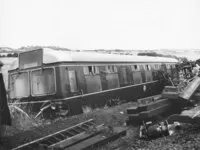
16th July 1961
One of a series of images credited to the LMR Mechanical & Electrical Engineers Department at Derby recording the aftermath of the collision on Singleton Bank (near Weeton) where a six-car DMU excursion struck the rear of a stationary ballast train on 16 July 1961. This is image 1, captioned "3rd. diesel rail car M.51780. Leading End after being moved from track." The vehicle was the third car in the train and was barely a year old. It would not be returned to traffic. British Railways.
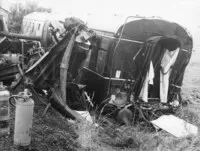
16th July 1961
One of a series of images credited to the LMR Mechanical & Electrical Engineers Department at Derby recording the aftermath of the collision on Singleton Bank (near Weeton) where a six-car DMU excursion struck the rear of a stationary ballast train on 16 July 1961. This is image 2, captioned "3rd. diesel rail car M.51780. Trailing End after being moved from track." British Railways.
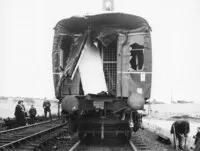
16th July 1961
One of a series of images credited to the LMR Mechanical & Electrical Engineers Department at Derby recording the aftermath of the collision on Singleton Bank (near Weeton) where a six-car DMU excursion struck the rear of a stationary ballast train on 16 July 1961. This is image 3, captioned "4th. diesel rail car M.51755. Leading End." The vehicle was the fourth car in the train, the partner to M51780. Clearly it is the rear end of the vehicle, 'leading end' in the caption probably refers to this end being the leading end at the time of the collision. It would be repaired and returned to traffic. British Railways.
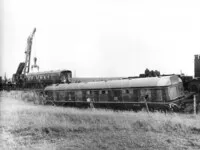
16th July 1961
One of a series of images credited to the LMR Mechanical & Electrical Engineers Department at Derby recording the aftermath of the collision on Singleton Bank (near Weeton) where a six-car DMU excursion struck the rear of a stationary ballast train on 16 July 1961. This is image 6, captioned "3rd. diesel rail car M.51780. In field after being moved from track." Behind, under the crane, is M51755, these two vehicles formed the second of the three two-car sets in the train. British Railways.
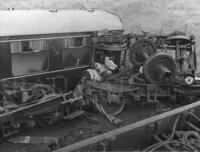
16th July 1961
One of a series of images credited to the LMR Mechanical & Electrical Engineers Department at Derby recording the aftermath of the collision on Singleton Bank (near Weeton) where a six-car DMU excursion struck the rear of a stationary ballast train on 16 July 1961. This is image 7, captioned "3rd. diesel rail car No. 51780. Rear end with bogies from 1st. & 2nd. vehicles Nos. M.50808 M.50783." The vehicle was the third car in the train and was barely a year old. It would not be returned to traffic. British Railways.
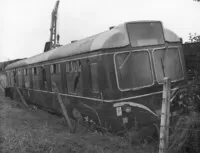
16th July 1961
One of a series of images credited to the LMR Mechanical & Electrical Engineers Department at Derby recording the aftermath of the collision on Singleton Bank (near Weeton) where a six-car DMU excursion struck the rear of a stationary ballast train on 16 July 1961. This is image 8, captioned "3rd. diesel rail car M.51780 (leading end) after being moved from track." British Railways.
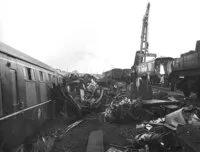
16th July 1961
One of a series of images credited to the LMR Mechanical & Electrical Engineers Department at Derby recording the aftermath of the collision on Singleton Bank (near Weeton) where a six-car DMU excursion struck the rear of a stationary ballast train on 16 July 1961. This is image 9, captioned "Engines etc. from 1st. three vehicles (up main line) of diesel M.U. train." On the left is M51780 and M51755 is on the track under the crane. British Railways.
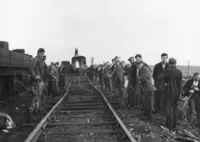
16th July 1961
One of a series of images credited to the LMR Mechanical & Electrical Engineers Department at Derby recording the aftermath of the collision on Singleton Bank (near Weeton) where a six-car DMU excursion struck the rear of a stationary ballast train on 16 July 1961. This is image 15, captioned "Down main line looking to rear of diesel M.U. train." British Railways.

16th July 1961
One of a series of images credited to the LMR Mechanical & Electrical Engineers Department at Derby recording the aftermath of the collision on Singleton Bank (near Weeton) where a six-car DMU excursion struck the rear of a stationary ballast train on 16 July 1961. This is image 17, captioned "Detached bogies on bank, diesel M.U. train". Behind is M51780. British Railways.

16th July 1961
One of a series of images credited to the LMR Mechanical & Electrical Engineers Department at Derby recording the aftermath of the collision on Singleton Bank (near Weeton) where a six-car DMU excursion struck the rear of a stationary ballast train on 16 July 1961. This is image 18, captioned "Trailing end of 4th. diesel rail car M.51755." British Railways.
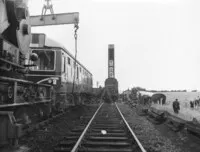
16th July 1961
One of a series of images credited to the LMR Mechanical & Electrical Engineers Department at Derby recording the aftermath of the collision on Singleton Bank (near Weeton) where a six-car DMU excursion struck the rear of a stationary ballast train on 16 July 1961. This is image 20, captioned "4th. diesel rail car M.51755 on down line. 3rd. diesel rail car M.51780 at right of up up main line." British Railways.

16th July 1961
One of a series of images credited to the LMR Mechanical & Electrical Engineers Department at Derby recording the aftermath of the collision on Singleton Bank (near Weeton) where a six-car DMU excursion struck the rear of a stationary ballast train on 16 July 1961. This is image 23, captioned "Up main line ballast train freight vehicles on right." Beyond the wagons can be seen the rear end of M51755, its partner M51780 is in the field to the left. A DMU engine sits on the track. British Railways.
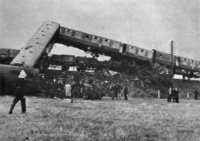
16th July 1961
The wreckage of the 8.50am Colne to Fleetwood service after colliding with a ballast train at Singleton Bank (near Weeton) on 16 July 1961. From left to right are 50808, 50783, 51780 and 51755. Image taken from the accident report. British Railways.

4th November 1961
The last days of the 1866-built Burnley Manchester Road, with a Preston to Todmorden service formed of a two-car Rolls-Royce diesel hydraulic Cravens DMU (Class '113') running into the up platform, with just one passenger and two railfans present on Saturday 4th November 1961. The closure notice can be noted on the down platform building, the station closing to passengers on the following Monday, 6th November 1961. Gordon Edgar Collection.

17th December 1961
DMBS of Class 113 No M51737 stands at the refueling shed at Neville Hill Leeds after arriving with a special train from Manchester on Sunday 17th December 1961. Delivered in December 1959 and built by Cravens at Sheffield, fitted with a Rolls-Royce 238 bhp engine and a Hydraulic Torque converter it was withdrawn in July 1969 and scrapped at T. W. Wards Briton Ferry in July 1970. Keith Long.


